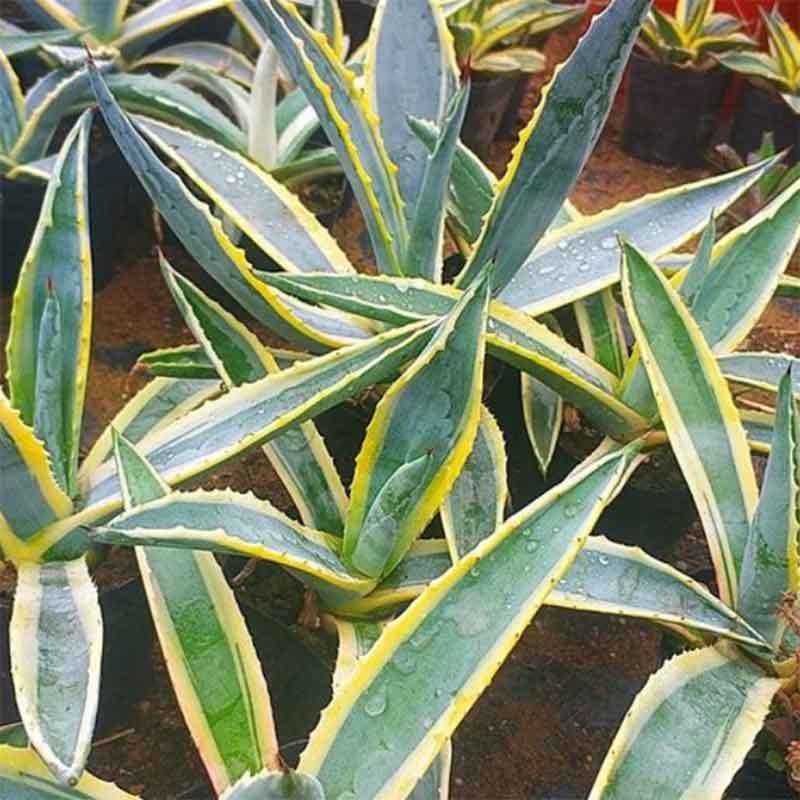Agave Leaves Turning Yellow [Causes & Fixes]
Introduction
Why is my agave plant turning yellow? Agaves, renowned for their hardiness, are iconic succulents. However, you should diagnose and treat the underlying cause promptly if yellow spots on agave leaves.
Why Are My Agave Leaves Turning Yellow?
Insufficient Watering
One of the leading culprits when agave leaf discoloration is underwatering. Signs of dehydration can be observed through the shriveling or wilting of the leaves. They eventually turn yellow and brittle.
Overwatering
Contrary to popular belief, too much water can be just as detrimental. Overwatered agaves may develop root rot. This leads to an inability to absorb nutrients properly. The leaves will turn yellow and soft.
Soil Issues
The quality of your soil is paramount. Agaves require a gritty, well-aerated mixture that drains quickly. This prevents water from pooling around the roots. Compacted or water-retentive soils can harbor bacteria and fungi. They attack the roots, leading to a cascade of symptoms including agave yellow leaves.
Sunlight and Temperature
When an agave's leaves turn yellow, the cause may be sunburn. This happens when an agave that is accustomed to shade or young agave are suddenly exposed to intense, direct sunlight. The UV rays damage the plant's tissue. This leads to yellow or brownish patches that initially mark the burn.
On the flip side, frost can be the adversary in cooler climates. Exposure to temperatures below 28°F (-2°C) can cause cellular damage. This manifests as yellow or blackened leaves.
Pests and Diseases
Pests and diseases are also common culprits. In particular, mealybugs can be a nuisance to agaves. These small, white insects extract sap from the plant. This leads to a weakening of the leaves and potential yellowing.
Furthermore, fungal infections, such as Anthracnose, can manifest as yellow spots or streaks on the leaves. It often starts with tips and spreading.

Prevention and Care
Proper Watering Techniques
Agaves need water, but not too much, and not too often. They're native to hot and dry regions. They've evolved to store water in their leaves and roots. A general rule of thumb is to water deeply, but infrequently.
Wait until the soil is completely dry before you water again. About an inch down for the first few inches. This might mean watering every two weeks or even just once a month. Adjust based on your climate. Agaves in arid regions might need more frequent watering. While those in humid climates might need less.
Soil Management
Improper soil can be a significant contributor to agave leaves turning yellow. You should provide your agave with the right soil conditions to promote healthy growth. Agaves thrive in a mixture that allows water to pass through quickly. Mix one part potting mix with one part sand for an easy-to-care-for combination.
If you have heavy clay soil, add organic matter to improve drainage. For example, compost. If you are growing agave in pots, consider drilling additional holes or adding a layer of gravel at the bottom.
Sunlight and Temperature
Sunburn is a common reason for agave plant yellow leaves. Especially if you move them too quickly from indoor environments to direct sunlight. The remedy here is gradual acclimation.
Introduce your plant to its new sunny locale slowly. Starting with just a few hours of morning light and increasing incrementally over two weeks. Conversely, if the leaves on your agave are pointing downward and the color is a pale green or yellowish tint, it's a signal they need more light.
A sudden chill extremes can lead to agave plant leaves turning yellow and even rot. The ideal temperature for agave is a balmy 72-78°F (22-26°C). But they can tolerate 50°F (10°C) at night.
To protect against frost, cover or bring potted plants indoors during cold spells. For the heat, shading and increased watering can provide relief. Also, ensure there is proper drainage for times when watering increases during the summer months.
Pest and Disease Management
As resilient as they are, agaves are not immune to pests and diseases. Mealybugs, scale insects, agave snout weevil, and spider mites are common nuisances. For an organic approach, use neem oil or insecticidal soap to manage infestations.
Proper ventilation and not allowing water to settle in the crown of the plant can prevent fungal problems. If disease does strike, a treatment of copper fungicide can often rectify the situation.
Pruning and Maintenance
The care of a healthy agave doesn't end with routine watering and sunlight. Regular maintenance is essential for the plant's health and aesthetic. For example, pruning dead and decaying leaves. Simply trim these unsightly portions with a sharp, sterile knife or pruning shears.
Fertilization
For agave growing outdoors, periodic fertilization can supplement their nutrients. Make sure no more than twice a year. However, take care to choose a fertilizer with a balanced NPK ratio that's suited to succulents.
Conclusion
Why is my agave turning yellow? Observe and experiment with changes can often lead you to the root cause of the issue. You will have a lush, green garden by giving careful attention to your agave's environment, watering habits, and soil nutrients.

